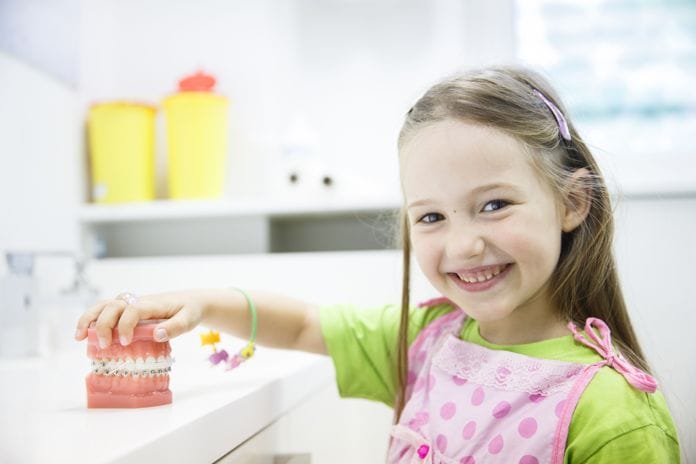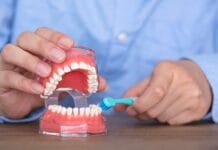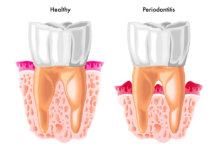Let’s travel back a few years, okay a few decades, to my first dental appointment. A state ran facility had established itself a little over a mile from my childhood home. I remember arriving that day, and the first thing that greeted me was a wad of blood-soaked gauze on the sidewalk outside. I remember starring in horror, but once inside the children’s nook captivated my attention. I sat in a kid-sized, orange, plastic chair around a table positioned in an alcove for children in the waiting room. Television and books were provided to help keep children entertained and did a successful job in doing so. When my name was called, I was escorted, sans mom, down what seemed like the world’s longest hallway to a treatment room. I remember sitting tall in the dental chair, and a woman talking to me briefly, who left promising she would be back with the dentist. THE DENTIST!
As I sat in that chair all alone, I remember fear captivating me as the unfamiliar sounds of dentistry came to life around me. I panicked as the fear of the unknown began closing in around me, and I began to scream for my mom frantically. She was there before any staff member could make it to my room, and immediately reassured me I would be fine. At some point, it was agreed that nitrous oxide would be a great option and the black hooded nose nicknamed Snoopy carried away my fears. I was a nightmare patient. To think that I am now on the opposite side of the chair five days a week still seems so ironic to me.
Treating children doesn’t have to be a nightmare. Just as it is in any situation, it is all about the approach. I have witnessed many dental professionals who have zero knack for treating children and each time I silently shake my head in disappointment. Of course, the outcome is a fear-instilled child who grows into an atrocious adult patient, who is complicated to treat. Fear is a learned behavior and one that is not easily shed. That is why it is pertinent to build trust from the initial appointment so that these children grow to become trusting adults that make your job just a little bit easier.
While many children will seek dental treatment from a pedodontist, not every child will. General dentistry offices may not have the entire kid-orientated montage in their waiting room; however, they are still highly capable of treating pediatric patients. It just may require some creativity or require bringing out the inner kid that lives inside us all.
Here are 10 tips that I use to ensure that children have a pleasant, rewarding visit.
1) First and most importantly, think like a kid.
When retrieving your pediatric patient from the reception area to come back to the treatment area, make sure to paint on a big smile because you only have one chance to make a good first impression. Children have the uncanny ability to read adults like a book, and they will respond accordingly. I always invite mom or dad (or grandparent) back with the child if I sense apprehension and resistance. Remember me, alone in a room scared to death and screaming?
2) I introduce myself and tell them something fun about myself that they can relate, like the fact I have twin six-year-old boys or that I have a monstrous dog.
Then I ask questions about themselves – School? Siblings? What did you get for Christmas? Sports? I feel it is extremely important always to address the child and not the adult. I pretend that the accompanying adult is not even present. This shows children that they are capable of undergoing dental treatment all by themselves, with confidence.
3) I walk them through each step, leaving any surprises out of the equation.
I find that if children know what to anticipate, they are more likely to cooperate willingly. I show them what I will use during treatment, and I let them touch the object. I do this because, often, they just need that reassurance.
4) Forget all the dental terminology you know!
Caries, saliva ejector, air/water syringe, and explorer, to name a few, are words that no child will be able to comprehend and using them will only add to the mounding fear inside their head. Rename these objects to something a child can easily grasp. I call the saliva ejector a vacuum cleaner, air/water syringe a water gun, and prophy paste – sparkle dust.
5) Slowly introduce each aspect of the appointment to the child.
Make sure that trust is gained before I always assure them that I will not do anything that is scary (avoiding using the word “hurt” or anything that implies it could hurt when it won’t) and I will not make decisions without them.
6) Never push a child past their comfort zone.
If a child isn’t comfortable proceeding, never force a child into treatment. I once had a mother hold her frantic child down and demand I scale his teeth. No go, momma. If a child has an obvious issue that needs to be addressed, I suggest making a referral to a pedodontist (if in general dentistry).
7) Sometimes the smallest gestures make the biggest impact.
I order a variety pack of fun prophy paste flavors to give my pediatric patients a choice. They remember from appointment to appointment what flavor they chose and love selecting new flavors.
8) PRAISE PRAISE PRAISE!
Every child loves to be commended for their efforts. I always brag and rave about how wonderful they are doing, which only encourages them to continue. Children are people pleasers by nature.
9) Give oral hygiene instructions to the child, not the adult.
The child doesn’t need to be talked over and should be treated as the priority they are. Afterwards, mom or dad can be addressed. Again, make this fun and engaging. Help them to relate so that they can comply.
10) Reward!
Offering incentives to cooperate will only help ensure that pediatric patients comply with I remember living for the treasure box after my dental appointments. Reach out to local business or restaurants, as many offer reward certificates for free fries or kid’s meals.
These are only a few suggestions in making the appointment for pediatric patients less traumatic for the child and far less stressful for you. Remember, tap into that inner child and have FUN!












